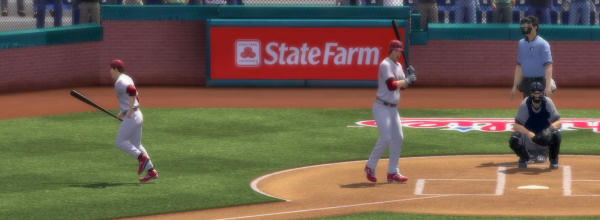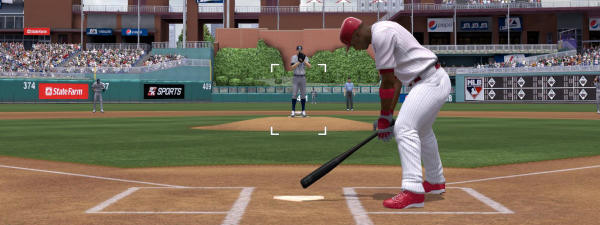Go Phillies: Major League Baseball 2K9 Demo
2K Sports' Major League Baseball 2K9 has a demo out this week, letting you play a three inning match between the Tampa Bay Rays and my beloved Phillies. Which was nice of them. Although maybe it's a psychic demo, and it automatically picks your team when you download it. It's literally impossible for me to say based on the evidence of my download, so let's say, given the evidence, that there's a 50% chance it's psychic, and 50 that it's a coincidence. That seems reasonable. Anyway, blimey, I enjoyed it.
Before the positives, a thousand rubbish-points to 2K for the terrible presentation of the demo. If there are instructions hidden in there, I'm buggered if I could find them. And despite seeming desperate that you play it with a 360 controller (the whole game is based around using the analogue sticks), it a) wouldn't tell me which button did what, and b) would only let me change the keyboard controls. It's quite an impressive misunderstanding of the purpose of a demo, determinedly alienating a player from the start. Oh, and why do all games have to emulate EA Sports' ghastly opening menus? Affronting me with something that sounded like Sum 41 when it loaded wasn't quite what I was after.
However, I'm glad I persisted. This is quite a bit of cartoonish fun. Once I'd fathomed what button did what, and thus lost a game 8-0 in the process, I felt most of the way in control. I'm still not entirely sure I'm pitching completely correctly, and it doesn't help by only very rarely telling you your pitch speed. It's hard to judge quite what the yellow circles meant.
Fielding was slightly more simple, especially once I'd figured out that each base was mapped to one of the four action buttons, making throwing the ball in the right direction pleasingly simple. Catching fly balls was also nice and easy, just a case of placing the fielder underneath the ball, rather than having to perform some intricate spell. Batting is a lot more clear, although I haven't quite figured out exactly what to do with the left analogue to get a good ground ball.
It's not going to win any approval from hardcore simulation players. It became clear that it's about being accessible (with some instructions), emphasis on arcade over simulation, which is precisely what I want from a baseball game. It's not reviewing well on consoles, so presumably it's not what everyone else wants. But from a position of baseball game ignorance (I can't find even this one on sale in the UK, much like most baseball games), the demo worked for me.
The ballpark details are oddly sparse. The backgrounds are poorly textured, and extremely plain. But the field, the players (but for their faces, but that's of little importance most of the time), and the action all looks great. A large shot of the crowd still looks like cardboard cut-outs in a diorama (the first sports game to figure that out wins a special prize), but slightly closer up when people get up off their chairs to fight over catching a foul ball, that's pretty damned awesome.
All the vital licensed details are in there, with accurate 09 teams, rosters, management, etc. Cuddly Phillies manager, Charlie Manuel, huffed and puffed across the field after I called him out to calm my pitcher down on the mound. Pitchers were warming up in the bullpen. Realistic weather rolled by. I even got Phillies' opening pitcher Hamels on base a couple of times, just underlining my maverick theory that his batting was the key to their glorious victory last year.
But most impressive, and this feels like the sort of sentence I'd never thought I'd ever type, the commentary was extraordinary. Sporting commentary is normally the first thing I turn off, for fear of hearing the same awkwardly shouted, peculiarly clipped phrase appear inappropriately for the third time in the last thirty seconds. ESPN's Gary Thorne and Steve Phillips are like nothing I've heard.
Not only were they chatting about the Phillies' 08 victory between pitches, commenting on Chase Utley's recent form, or having a thought on Manuel's management, they were... saying relevant things about what I was doing! I had Hamels deliberately hit the Rays' pitcher on the plate (fnarr), and there was a seamless comment about how pitcher hitting pitcher was an unusually risky move, and pondering on whether there would be revenge at Hamels' next at bat. Later, I'd pitched away from a batter, trying to get him to reach. That failed so I followed up by pitching tight inside. The play-by-play commentary observed this, described exactly what I'd done, and why a pitcher might have followed one pitch with the other. The back-references extend a lot further too, with events late in an inning being connected to those that happened earlier. Having let in a couple of runs at the start was factored in when an RBI cropped up with later with two outs. Of course, this is based on a couple of three-inning games, so perhaps in the full version the usual repetition might kick in. But in this brief experience, I was blown away.
It's left me really interested to play the full game. It's time to start getting worked up for the new season, start not going to bed before 4am again for the first couple of weeks before I come to my senses and start watching games from the MLB TV archive rather than live, until September when I just give up on the idea of sleep altogether. It's good for the mood! Anyway, it's a hefty 1.25GB, and possibly of limited interest to non-US readers. Did it for me.



